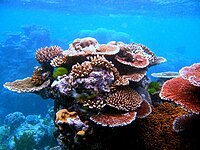
Photo from wikipedia
The effect of hay type on the microbiome of the equine gastrointestinal tract is relatively unexplored. Our objective was to characterize the cecal and fecal microbiome of mature horses consuming… Click to show full abstract
The effect of hay type on the microbiome of the equine gastrointestinal tract is relatively unexplored. Our objective was to characterize the cecal and fecal microbiome of mature horses consuming alfalfa or Smooth Bromegrass (brome) hay. Six cecally cannulated horses were used in a split-plot design run as a crossover in two periods. The whole plot treatment was ad libitum access to brome or alfalfa hay fed over two 21-d acclimation periods with subplots of sampling location (cecum and rectum) and sampling hour. Each acclimation period was followed by a 24-h collection period where cecal and fecal samples were collected every 3 h for analysis of pH and volatile fatty acids (VFA). Fecal and cecal samples were pooled and sent to a commercial lab (MR DNA, Shallowater, TX) for the amplification of the V4 region of the 16S rRNA gene and sequenced using Illumina HiSeq. The main effects of hay on VFA, pH, and taxonomic abundances were analyzed using the MIXED procedure of SAS 9.4 with fixed effects of hay, hour, location, period, and all possible interactions and random effect of horse. Alpha and beta diversities were analyzed using the R Dame package. Horses fed alfalfa had greater fecal than cecal pH (P ≤ 0.05), whereas horses fed brome had greater cecal than fecal pH (P ≤ 0.05). Regardless of hay type, total VFA concentrations were greater (P ≤ 0.05) in the cecum than in feces, and alfalfa resulted in greater (P ≤ 0.05) VFA concentrations than brome in both sampling locations. Alpha diversity was greater (P ≤ 0.05) in fecal compared with cecal samples. Microbial community structure within each sampling location and hay type differed from one another (P ≤ 0.05). Bacteroidetes were greater (P ≤ 0.05) in the cecum compared with the rectum, regardless of hay type. Firmicutes and Firmicutes:Bacteroidetes were greater (P ≤ 0.05) in the feces compared with cecal samples of alfalfa-fed horses. In all, fermentation parameters and bacterial abundances were impacted by hay type and sampling location in the hindgut.
Journal Title: Journal of animal science
Year Published: 2021
Link to full text (if available)
Share on Social Media: Sign Up to like & get
recommendations!